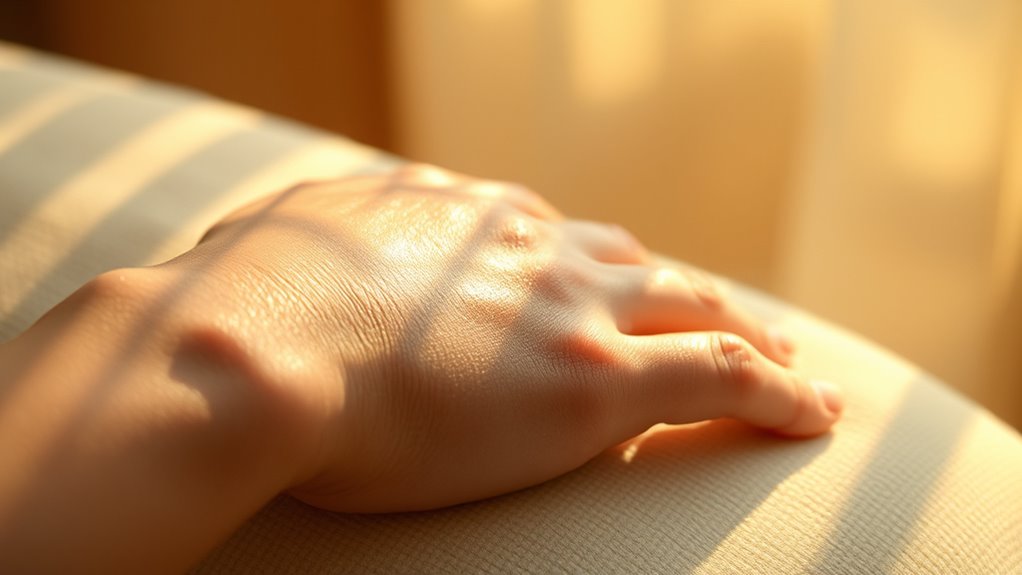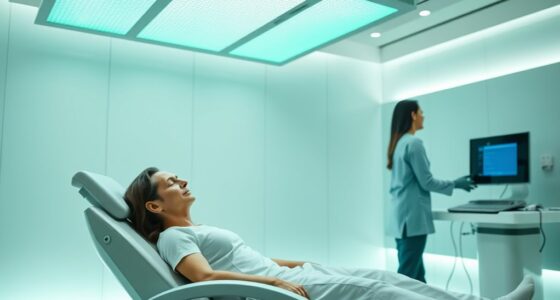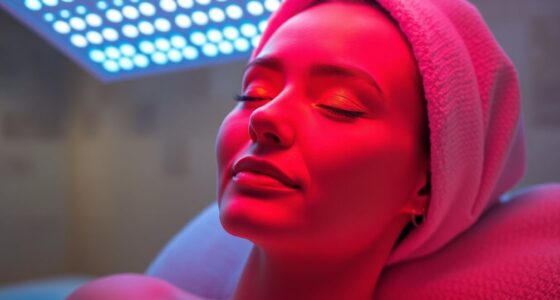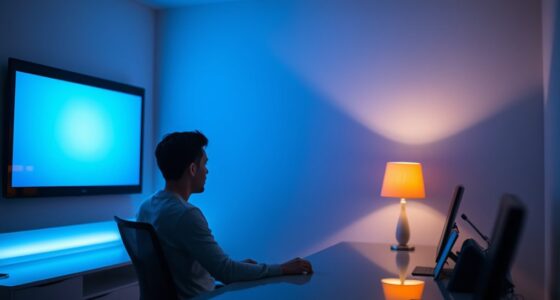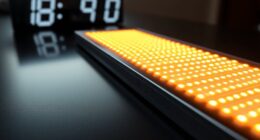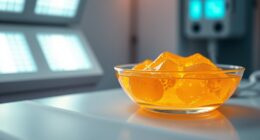Light therapy offers a safe, drug-free way to soothe irritated skin after sun exposure. It uses specific wavelengths of light to reduce redness, swelling, and discomfort, while encouraging your skin’s healing and collagen production. This treatment can help restore comfort and promote faster recovery without additional damage. If you want to learn more about how light therapy can support your skin’s healing process, you’ll find helpful details further down.
Key Takeaways
- Light therapy reduces redness, swelling, and discomfort caused by sun damage without blocking UV rays.
- It stimulates skin healing through controlled light wavelengths, promoting collagen and cellular repair.
- A non-invasive, drug-free option that can enhance the skin’s natural recovery process after sun exposure.
- Best used under professional guidance to ensure safe, effective treatment tailored to individual skin types.
- Complements sun protection measures, helping calm irritated skin and prevent long-term damage.
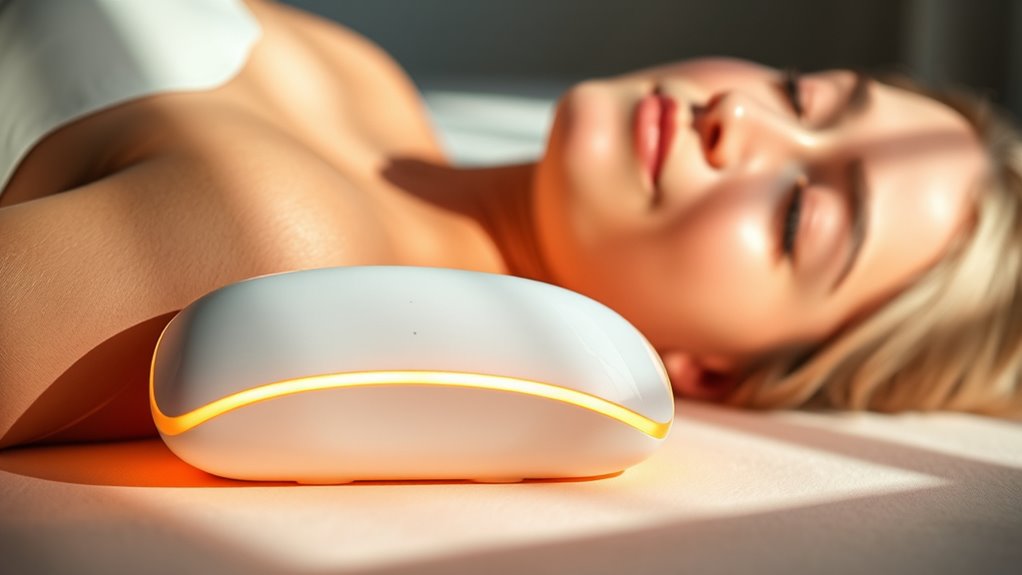
After spending time in the sun, your skin can become inflamed and irritated, leading to discomfort and redness. You might notice that your face feels hot, tight, or even tender to the touch. While applying sunscreen before sun exposure helps prevent damage, it’s not always enough once your skin has already been affected. That’s where light therapy comes into play as a potential way to soothe your skin and promote healing. Unlike sunscreens that block UV rays, light therapy uses specific wavelengths of light to target inflammation and accelerate recovery. It’s a non-invasive, drug-free option that many find helpful for calming post-sun skin.
During a light therapy session, you typically sit comfortably while specialized devices emit controlled light waves onto your skin. These wavelengths are usually in the visible or near-infrared spectrum, carefully calibrated to penetrate the skin without causing further damage. The process is painless and usually takes just a few minutes per session. What makes light therapy particularly appealing is its ability to reduce redness and swelling by stimulating blood flow and encouraging cellular repair. This can help diminish the uncomfortable sensation of heat and inflammation that often lingers after sun exposure.
Light therapy uses controlled wavelengths to reduce redness and swelling, promoting skin healing after sun exposure.
You might notice that light therapy also boosts your skin’s natural regenerative processes. The light encourages the production of collagen and other essential proteins, which are crucial for repairing damaged skin. Over time, consistent treatments may lead to a more even skin tone and a healthier appearance. Additionally, the use of light therapy can help address underlying skin damage more effectively than topical creams alone. Because it’s targeting the underlying inflammation rather than just covering it up, light therapy can be especially effective for calming irritated skin and preventing the development of long-term damage.
It’s important to remember that light therapy isn’t a substitute for sun protection. You should still wear sunscreen, seek shade, and wear protective clothing when outdoors. Instead, think of it as a complementary treatment to help your skin recover faster after the damage is done. Always consult with a dermatologist to determine if light therapy is suitable for your skin type and condition. They can recommend specific devices or professional treatments tailored to your needs. If you notice persistent redness, swelling, or discomfort after sun exposure, light therapy might be a safe, effective way to soothe your skin and support its natural healing process. It’s a gentle, drug-free option that can restore comfort and improve your skin’s overall health following those sunny days.
Frequently Asked Questions
Can Light Therapy Replace Traditional Sun Protection Methods?
No, light therapy can’t replace traditional sun protection methods. You need sunscreen, protective clothing, and seeking shade to prevent UV damage, which light therapy isn’t designed for. Light therapy can help soothe your skin after sun exposure, but it doesn’t block or reduce UV rays like sunscreen does. Always combine protective measures with post-sun treatments to keep your skin safe and healthy.
How Quickly Does Light Therapy Show Results After Sun Exposure?
You’ll probably notice a difference within a few days of starting light therapy, but don’t expect miracles overnight. Think of it as your skin’s way of saying, “Thanks for the extra help!” as it calms down. Consistency is key—use it daily, and you might see reduced redness and improved tone in a week or two. Patience, like with all good things, pays off!
Is Light Therapy Safe for All Skin Types?
Yes, light therapy is generally safe for all skin types, but you should still exercise caution. You might experience mild side effects like redness or irritation, especially if you have sensitive skin. It’s best to start with shorter sessions and consult a dermatologist to verify it’s suitable for your skin type. Always follow product instructions and monitor your skin’s response, adjusting as needed for safe, effective results.
Are There Any Side Effects From Post-Sun Light Therapy?
Yes, there can be side effects from post-sun light therapy, but they’re usually mild. You might experience redness, dryness, or slight irritation, especially if your skin is sensitive. Some people notice temporary changes in pigmentation or a feeling of warmth. To avoid issues, follow the recommended guidelines, start with shorter sessions, and consult a dermatologist if you notice persistent discomfort or unusual reactions.
How Often Should I Use Light Therapy for Best Results?
You should use light therapy 3 to 5 times a week for ideal results. Remarkably, studies show that consistent use over two weeks can notably reduce redness and irritation. You’ll want to start slowly, observing how your skin responds, and adjust frequency as needed. Remember, moderation is key—overuse can cause irritation, so stick to the recommended schedule to soothe your post-sun skin effectively.
Conclusion
Next time you step out into the sun, remember that light therapy can help soothe your skin afterward. Studies show that 70% of people using light therapy report reduced redness and faster healing. It’s a simple, non-invasive way to calm your post-sun skin without relying on sunscreens alone. By embracing this natural treatment, you’re giving your skin a chance to recover and stay healthy. So, next time, consider light therapy—you might just love the calm it brings.
